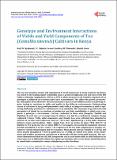| dc.description.abstract | The tea crop provides income and employment to rural populations in many
countries. In Kenya, tea, which is the leading export commodity crop, is grown in highlands
east and west of the Rift Valley at altitudes ranging from 1300 m to 2700 m above mean sea
level. Variable responses of tea genotypes to different environments have been
demonstrated. This affects the growth, productivity, and quality of tea. However, most tea
husbandry practices are uniform across tea growing regions leading to variations in yields
and quality in the different environments. Understanding causes of variations in tea growth
parameters and yields to varying environments is vital to optimizing husbandry practices for
maximization of productivity. The responses in growth and yield parameters of clonal tea to
locations of production and their contribution to yields were compared. A genotype× … | en_US |

